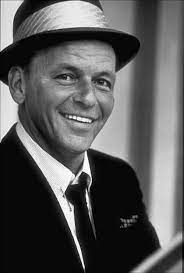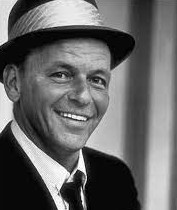Today is Frank Sinatra’s 97th birthday anniversary. Right from the outset of Jazz a la Mode in 1984, Sinatra was in the mix. I’d been listening to jazz shows for over a decade at that point and noticed how infrequently his records were played by other jazz jocks, so I knew that spinning Sinatra was slightly unorthodox. Still, I was a bit surprised by the intensity of the reaction I got from several listeners who wrote or called to argue that Sinatra was not a jazz singer. I used to answer that if he qualified as Lester Young’s favorite, that was qualification enough for me, too. 28 years later, Sinatra’s still in the mix, and who knows but that the possibility of hearing one of his records is what keeps some listeners tuning in night after night, and how the promise of a little Sinatra might make it possible for us to hear many other well and lesser-known jazz masters.

I’ve enjoyed reading of Sinatra in recent publications by the singers Carol Sloane and John Pizzarelli, and by the journalist and blogger Marc Myers. Let me begin with this knowing appreciation by Carol, whose blog, SloaneView, offered a birthday tribute to Sinatra last Friday. It reads, in part, “Even in the very early stages of my life, Frank Sinatra impressed me with his phrasing, his sound completely impossible to duplicate: his placement (intonation) was perfect, i.e., he always nailed each note with unwavering accuracy. He didn’t have to add a hint of melisma to help his voice glide with style and grace from one interval to the next because for him, even the most demanding intervals were never more of a challenge than the simple act of breathing.
“His voice reproduced the music as written, and to add to his sonorous appeal, he could also transmit a sense of having experienced the joy or pain of a lyric, always getting the ‘read’ right.”
John Pizzarelli’s newly published memoir, World on a String, takes its name from the Harold Arlen-Ted Koehler song, which also happens to be the insouciant tune Sinatra kicked off his concerts with for many years, and that Gay Talese employed as a motif in his famous essay for Esquire, “Frank Sinatra Has a Cold.” Pizzarelli knows firsthand the experience of Sinatra concerts, and a different kind of cold, too, as he served as an opening act for his fellow Jerseyite on a 1993 tour. He was a 33-year-old then, and his father Bucky had played on various Sinatra dates, but he was as star-struck as anyone upon meeting the man.
Pizzarelli writes, “You’ve heard this before, now you’ll hear it from me. The gods had blessed this gentleman with the bluest eyes I had ever seen, somewhere between the daytime sky of Rio de Janeiro and the color produced by the jets of my parents’ gas stove. But after forcing Mr. Sinatra to endure about thirty seconds of the most lame patter produced outside the confines of a freshman mixer at Don Bosco, his famous eyes took on a certain blankness that unmistakably announced, ‘This conversation is over’.”
Later he recounts the experience of watching Sinatra rehearse before a tour stop in Atlanta. “After someone shouted, ‘Let’s start from the top,’ all twenty-six pieces hit the intro, but the vocalist wasn’t humming the lyrics this time. On an unbearably hot night in Atlanta and for three magical songs—‘The House I Live In,’ ‘Come Rain or Come Shine,’ and ‘Luck Be a Lady’—the Old Man somehow recaptured his legendary swagger and his early-sixties pipes. Focusing on the five of us [Pizzarelli’s group] sitting just a few rows from the stage, he confidently smiled and played to us. It was the look of an aging pitcher, almost startled to realize during a random game in August that he still had his finest stuff…All too soon the singer…[left ] us in amazed silence before we began clapping wildly. I felt tears roll down my cheeks [over] the best singing I had ever heard.”
Marc Myers provides essential reading on his daily blog JazzWax and reports on music and musicians for the Wall Street Journal. The social implications of jazz are a common concern of Myers’ writing, and his new book, Why Jazz Happened, focuses primarily on the years 1942-’72, a period that Myers sees as the golden age of jazz as an art form. Why Jazz Happened draws extensively on the interviews Myers has published in JazzWax, and he’s woven these together with a smart historical overview to write a highly readable account of the impact that various social forces have had on the music.
Sinatra figures prominently in Myers’ account of the rioting that beset the Benjamin Franklin High School in the Italian neighborhood of East Harlem when the first attempts at de-segregating New York public schools were made in 1945. Talese called Sinatra “a kind of one-man Anti-Defamation League for Italians in America,” and Myers reports that Mayor LaGuardia asked him to speak to the school’s students. “On October 23, just weeks ahead of the release of Sinatra’s short film, “The House I Live In,” which featured a plot similar to the real-life drama that had unfolded in East Harlem that September, the singer traveled up to the school’s auditorium to ‘lay it on the line,’ as the Daily News described his mission.”
Sonny Rollins was a 15-year-old Harlemite on the front lines at the time. He recalls in Why Jazz Happened, “We didn’t know we were going to be met with this kind of stuff when we first got to the school that September. For us, we were just going to a nice new school. Of course, if I had thought it through, it did look as though we were invading their neighborhood. When Sinatra came, we were in the auditorium—all the kids. He was Italian, and everyone knew and loved him. Sinatra said, ‘Don’t fight, be friends, get along.’ It was great. I was a Sinatra fan. Soon after the Nat Cole Trio came to the school. Nat gave a similar speech and played and sang. In just two weeks, we had a chance to see two of the country’s top entertainers. After they came, things changed. There was no more fighting. After that, I knew Italian people, and they knew black kids. Everyone got along. Only music can do this.”
Sinatra’s daring lead wasn’t lost on Duke Ellington, who wrote with great affection for the singer in his memoir, Music Is My Mistress. “Every song he sings is understandable and, most of all, believable, which is the ultimate in theater. And I must repeat and emphasize my admiration for him as a non-conformist…I don’t know of anybody else who would have done anything to jeopardize his position so soon after reaching a peak of success, but Francis Sinatra decided—I’m sure against the wishes of his advisors and yes-men—to do what is usually considered dangerous and damaging to a budding career. He went ahead and made a tour of racially disturbed high schools in New York City preaching racial tolerance.”
Duke continued his appreciation with this tale from the early ‘50’s. “We were playing Las Vegas when some of my cats were nabbed in a raid. The newspapers played it up as a big thing. What did Francis do the very next night? He came to visit and hear our show. He brought a party of thirty people, and they gave us the bravos of the giants. After that, the good citizens forgot about the raid.”
We’ll hear Sinatra in tonight’s Jazz a la Mode, and Joe Williams too, as it’s his 94th birthday anniversary today. I’m sure he and Sinatra crossed paths over the years; I’m even surer that they were a mutual admiration society. Sinatra rarely sang the blues, perhaps because in that rarefied air, Joe had it covered, but something tells me Sinatra’s way with standards was a model for Williams, who became a consummate ballad singer in his later years.
Here’s Joe singing “Muddy Water” and putting smiles on the faces of Bill and Hillary Clinton, Kareen Abdul Jabbar, and a band boasting Red Rodney, Jon Faddis, Jimmy Heath, Joe Henderson, Christian McBride, and Grover Washington, Jr.
